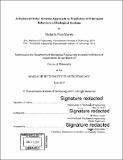A reduced order systems approach to prediction of emergent behaviors of biological systems
Author(s)
Mayalu, Michaëlle Ntala
DownloadFull printable version (19.65Mb)
Other Contributors
Massachusetts Institute of Technology. Department of Mechanical Engineering.
Advisor
H. Harry Asada.
Terms of use
Metadata
Show full item recordAbstract
One of the most fundamental questions in developmental biology and tissue engineering is how cells organize to form complex structures characterized by tissues, organs and whole organisms. The coordination of cells to form complex structures is facilitated by their communication via the surrounding gel (or extracellular matrix) where they live. In addition to answering questions in development, studying how cells communicate and coordinate over distance via the extracellular matrix (ECM) can give insight into pathological situations such as cancer metastasis, and wound healing. Although the exchange of molecular and biochemical signals is a key mechanism in cell to cell communication, cells can also communicate biomechanically through the ECM. Modeling mechanical interactions between cells and the ECM can advance understanding of biomechanical signaling during tissue formation. Observation of the mechanisms for mechanical interaction between contractile cells within an extracellular matrix has resulted in detailed models that can describe single-cell migration and spreading on (and within) various of substrates. By incorporating sub-cellular behaviors (such as focal adhesion dynamics, cytoskeleton remodeling, actin motor activity and remodeling of the surrounding fibrous matrix), these models can integrate both the purely mechanical interaction within the surrounding matrix as well as the internal adaptive response to mechanical cues from the surrounding matrix. As a result, a vast amount of simulation data can be created from analyzing single-cell/matrix interactions numerically. In addition, numerous cell types and environmental conditions may be represented by varying multiple parameters within the model. However, complex and extensive mechanisms involved in emergent behavior of multiple interacting cells and surrounding matrix may become intractable due to mathematical and computational complexity. This thesis will address how we can exploit simulation data describing the nonlinear dynamics of single-cell/matrix behavior to create a reduced-order linear state equation in latent variable space. Furthermore, in order to predict multi-cell emergent behavior, the reduced-order linear models of single cells are used as components in a comprehensive framework based on linear superposition of mutually shared matrix dynamics. The linear latent state equation describing the nonlinear dynamics of a single-cell and surrounding matrix is created in three steps. First, using Bond Graph Theory, a set of independent state equations(derived from the bond graph) may be augmented by adding equations using auxiliary variables necessary to "sufficiently inform" the nonlinear dynamics. This creates an augmented state space where a linear description of the nonlinear system can be found. Second, the augmented (auxiliary and state) variables are simulated for various initial conditions. Using the resulting simulated data, we perform Principal Component Analysis in order to approximate a lower dimensional linear manifold within the augmented space. Third, we transform the augmented state equation to latent space representation by orthogonal projection onto the basis defined within the lower dimensional linear manifold. While the resultant latent state equation is linear, complex nonlinearities are embedded in the compact model, leading to precise and global linearization of nonlinear dynamics. Using the linear representation of single-cell/matrix dynamics we may perform linear operations such as projection, to isolate matrix dynamics of individual cells, and superposition, to combine matrix dynamics of individual cells and approximate a multi-cell matrix environment. Using these linear operations, we can effectively link single-cell models to predict multi-cell emergent behaviors. The hypothesis to prove (drawn from experimental evidence) is that multiple cells can effectively interact by transmitting force to neighboring cells through the shared matrix environment. In this thesis, I consider two models describing the nonlinear dynamics of single-cell/ECM mechanics. The first model is a 1-D lumped parameter model created to explore the aspects of cell sensing over an elastic ECM. Although it is possible to reproduce bio-mechanical interactive behaviors, polarity is not considered within the 1-Dmodel. The second model is a highly detailed biophysical distributed parameter system describing cell/ECM mechanics based on previous works and can accurately reproduce experimental observations.
Description
Thesis: Ph. D., Massachusetts Institute of Technology, Department of Mechanical Engineering, 2017. Cataloged from PDF version of thesis. Includes bibliographical references (pages 125-129).
Date issued
2017Department
Massachusetts Institute of Technology. Department of Mechanical EngineeringPublisher
Massachusetts Institute of Technology
Keywords
Mechanical Engineering.